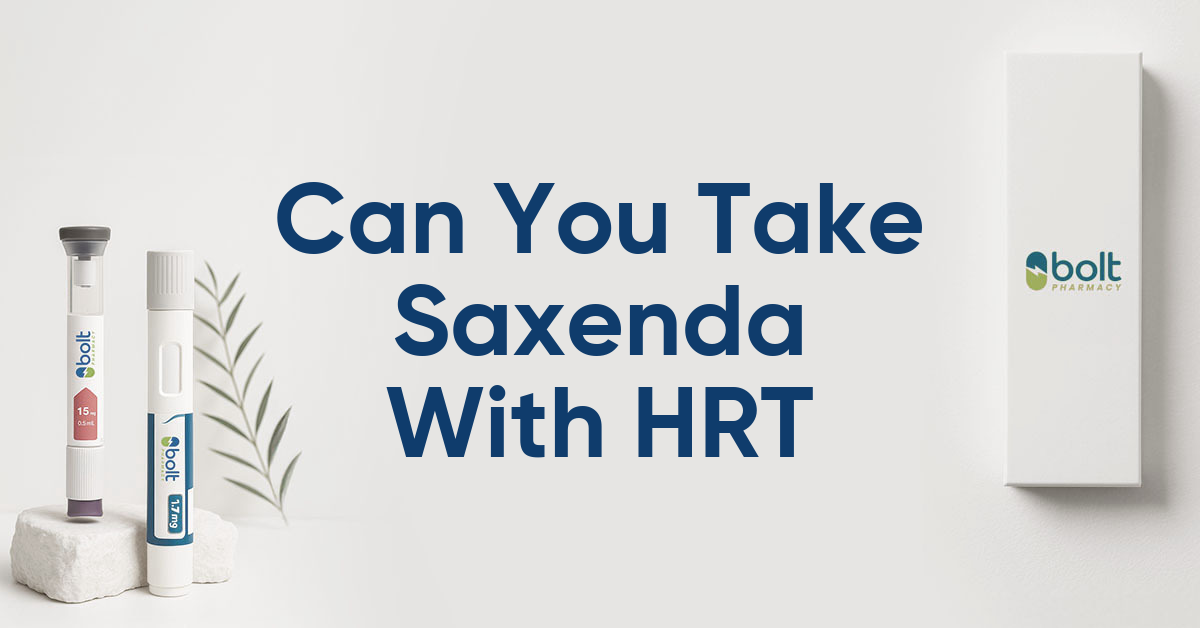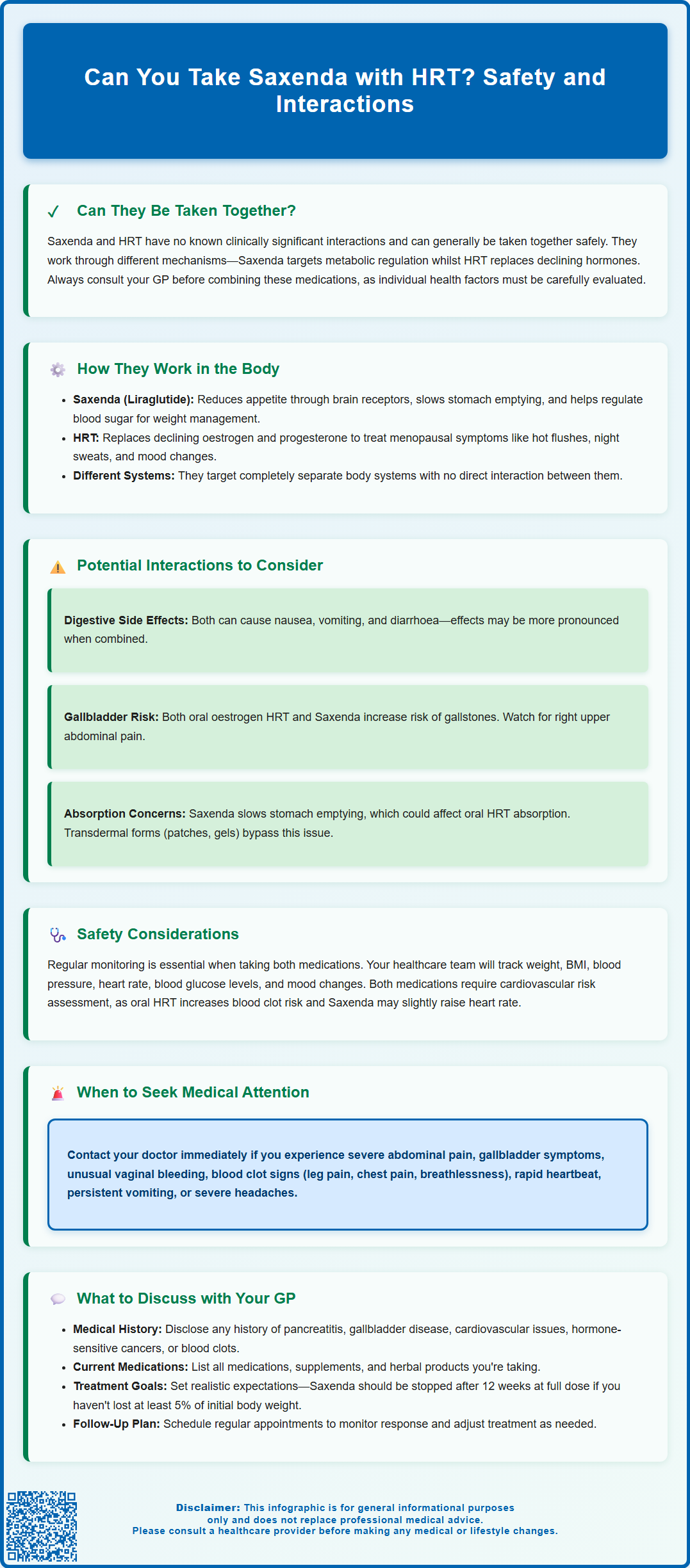Wegovy®
A weekly GLP-1 treatment proven to reduce hunger and support meaningful, long-term fat loss.
- ~16.9% average body weight loss
- Boosts metabolic & cardiovascular health
- Proven, long-established safety profile
- Weekly injection, easy to use

Can you take Saxenda with HRT? Many women approaching or experiencing menopause consider weight management options like Saxenda (liraglutide) alongside hormone replacement therapy. There is no known clinically significant interaction between these medications—they work through different mechanisms and are not known to affect each other's metabolism or efficacy. However, individual health factors, existing medical conditions, and treatment goals must be carefully considered. The decision to use both medications together should always be made in consultation with your GP or prescribing clinician, who can assess your specific circumstances and ensure appropriate monitoring.
Summary: Saxenda and HRT can generally be taken together as there is no known clinically significant interaction between these medications.
Many women approaching or experiencing menopause may be prescribed hormone replacement therapy (HRT) whilst also considering weight management options such as Saxenda (liraglutide). The question of whether these medications can be taken together is increasingly common in clinical practice.
The short answer is that there is no known clinically significant interaction between Saxenda and HRT. These medications work through different mechanisms and are not known to interact directly with one another. Saxenda is a glucagon-like peptide-1 (GLP-1) receptor agonist used for weight management as an adjunct to a reduced-calorie diet and increased physical activity. HRT replaces hormones that decline during menopause, primarily to control menopausal symptoms. Neither medication is listed as affecting the metabolism or efficacy of the other in current UK prescribing information.
However, the decision to use both medications together should always be made in consultation with your GP or prescribing clinician. Individual health factors, existing medical conditions, and your overall treatment goals must be carefully considered. Women with certain conditions may require additional monitoring when using Saxenda, regardless of HRT use.
It is worth noting that weight changes during menopause are complex and multifactorial. While HRT's primary purpose is to manage menopausal symptoms such as hot flushes and night sweats, not weight management, some women may experience changes in body composition during treatment. Your healthcare provider can help determine the most appropriate approach based on your individual circumstances, medical history, and treatment objectives.
Understanding how each medication functions helps clarify why they can generally be used together without direct interaction.
Saxenda (liraglutide) is a GLP-1 receptor agonist administered as a daily subcutaneous injection. It mimics the action of naturally occurring GLP-1, a hormone released by the intestine in response to food intake. Saxenda works through several mechanisms to promote weight loss:
Appetite regulation: It acts on areas of the brain involved in appetite control, helping to reduce hunger and increase feelings of fullness
Gastric emptying: It slows the rate at which food leaves the stomach, prolonging satiety after meals
Glucose regulation: While improvements in glycaemic measures can occur with Saxenda, it is not indicated for treating diabetes (the same active ingredient at a lower dose is marketed as Victoza for diabetes)
Saxenda is licensed in the UK for weight management in adults with a body mass index (BMI) of 30 kg/m² or greater, or 27 kg/m² or greater in the presence of weight-related comorbidities such as type 2 diabetes or hypertension, as an adjunct to a reduced-calorie diet and increased physical activity.
Hormone replacement therapy (HRT) works by supplementing oestrogen (and often progestogen in women with a uterus) that naturally declines during perimenopause and menopause. HRT preparations vary widely—including tablets, patches, gels, and vaginal preparations—and may contain oestrogen alone or combined with progestogen. HRT primarily addresses menopausal symptoms such as hot flushes, night sweats, mood changes, and vaginal dryness. It may also provide benefits for bone health and, for some women who start treatment before age 60 or within 10 years of menopause, may have a favourable risk-benefit profile regarding cardiovascular health. However, HRT is not indicated for cardiovascular disease prevention.
Because these medications target entirely different physiological systems—metabolic regulation versus hormonal replacement—they do not directly interfere with each other's primary mechanisms of action.

Whilst there is no established pharmacological interaction between Saxenda and HRT, several considerations are relevant when using both medications.
Metabolic effects: Both medications can influence body composition and metabolism, though through different pathways. HRT may influence fat distribution during menopause, though evidence for its effects on weight is mixed. Saxenda promotes weight loss primarily through appetite suppression and delayed gastric emptying. When used together, individual responses vary considerably.
Gastrointestinal effects: Saxenda commonly causes gastrointestinal side effects, particularly during dose escalation. These include nausea, vomiting, diarrhoea, and constipation. Some forms of HRT, particularly oral preparations, can also cause gastrointestinal symptoms in some women. When taking both medications, there may be an additive effect on digestive symptoms, though this is not a formal drug interaction. If gastrointestinal side effects become problematic, your clinician may adjust dosing schedules or consider alternative HRT formulations such as transdermal patches or gels, which bypass first-pass hepatic metabolism.
Absorption considerations: Saxenda slows gastric emptying, which theoretically could affect the absorption of oral medications. However, studies with oral contraceptives showed minimal impact on drug exposure with liraglutide, and while specific data for oral HRT is limited, significant clinical impact is unlikely. Transdermal HRT preparations (patches, gels) are absorbed directly through the skin and would not be affected by Saxenda's effects on the gastrointestinal tract.
Gallbladder considerations: Both oral oestrogens and GLP-1 receptor agonists like Saxenda can increase the risk of gallbladder problems, particularly gallstones. Rapid weight loss may also contribute to this risk. Be alert to symptoms such as right upper quadrant pain or jaundice.
Cardiovascular considerations: Both medications require careful assessment in women with cardiovascular risk factors. HRT carries specific considerations regarding thrombotic risk, particularly with oral preparations (transdermal routes have lower VTE risk), whilst Saxenda may increase heart rate slightly. Your GP will evaluate your overall cardiovascular risk profile when considering both treatments.
When taking Saxenda and HRT concurrently, several safety considerations warrant attention to ensure optimal outcomes and minimise potential risks.
Monitoring requirements: Women using both medications should maintain regular contact with their healthcare team. For Saxenda, this typically includes:
Weight and BMI monitoring: Regular assessment to evaluate treatment response
Blood pressure and heart rate checks: Saxenda typically causes a modest increase in heart rate and may slightly lower blood pressure
Blood glucose levels: Particularly important in women with diabetes or prediabetes
Mood changes: Monitor for depression or suicidal thoughts, which require prompt medical attention
For HRT, monitoring depends on individual risk factors but may include blood pressure checks and, in some cases, review of cardiovascular risk factors.
Recognising adverse effects: Be aware of potential side effects from each medication. For Saxenda, contact your GP promptly if you experience:
Severe or persistent abdominal pain (potential pancreatitis)
Signs of gallbladder problems (pain in the upper right abdomen, fever, yellowing of skin or eyes)
Rapid heartbeat or palpitations
Severe nausea or vomiting preventing adequate fluid intake
Signs of dehydration
Depression or suicidal thoughts
For HRT, seek medical advice if you notice:
Unusual vaginal bleeding
Signs of blood clots (leg pain, swelling, chest pain, breathlessness)
Severe headaches or visual disturbances
Breast lumps or changes
Seek emergency care (call 999 or go to A&E) if you experience chest pain, sudden breathlessness, or severe abdominal pain with fever or jaundice.
Special considerations:
Pregnancy and breastfeeding: Saxenda is not recommended during pregnancy or breastfeeding. Use effective contraception while taking Saxenda and inform your doctor immediately if you become pregnant.
Diabetes medications: If you have diabetes and use insulin or sulfonylureas, your doctor may need to adjust these medications to prevent hypoglycaemia when starting Saxenda.
Do not combine with other GLP-1 receptor agonists such as semaglutide, exenatide, or liraglutide for diabetes.
Lifestyle factors: Both medications work best alongside healthy lifestyle modifications. A balanced diet, regular physical activity, adequate hydration, and smoking cessation (if applicable) enhance the benefits of both Saxenda and HRT whilst reducing potential risks.
If you experience any suspected side effects from either medication, report them to the MHRA Yellow Card scheme (yellowcard.mhra.gov.uk).
Before commencing treatment with Saxenda, HRT, or both medications together, a comprehensive discussion with your GP or specialist is essential to ensure safe and appropriate prescribing.
Medical history review: Provide your clinician with a complete medical history, including:
History of pancreatitis or gallbladder disease
Cardiovascular disease or risk factors
Personal or family history of breast cancer or other hormone-sensitive cancers
History of venous thromboembolism (blood clots)
Kidney or liver problems
Diabetes or other endocrine disorders
Mental health conditions, including depression
Pregnancy plans, current pregnancy, or breastfeeding status
Thyroid conditions
Current medications: Inform your GP about all medications you currently take, including prescription medicines, over-the-counter preparations, and herbal supplements. Whilst Saxenda and HRT do not directly interact, other medications may influence the safety or efficacy of either treatment. Specifically mention if you are taking any other GLP-1 receptor agonists, as these should not be used alongside Saxenda.
Treatment goals and expectations: Discuss your specific objectives for each medication. For Saxenda, realistic weight loss expectations should be established—the Saxenda product information states that treatment should be discontinued after 12 weeks on the maintenance dose (3.0 mg daily) if at least 5% of initial body weight has not been lost. For HRT, clarify which menopausal symptoms you hope to address and discuss the most appropriate formulation and route of administration.
Risk-benefit assessment: Your GP will help you weigh the potential benefits against risks for your individual circumstances. This includes discussing the duration of treatment, particularly for HRT, where the benefits and risks change over time. For Saxenda, the intended duration of treatment and criteria for continuation should be established.
Follow-up arrangements: Agree on a monitoring schedule with regular review appointments to assess treatment response, manage side effects, and adjust therapy as needed. This collaborative approach ensures both medications are used safely and effectively to support your health goals during and after menopause.
Saxenda slows gastric emptying, which theoretically could affect oral medication absorption, but studies show minimal clinical impact. Transdermal HRT preparations (patches, gels) are absorbed through the skin and would not be affected by Saxenda's gastrointestinal effects.
Monitor for gastrointestinal symptoms (nausea, vomiting, diarrhoea), signs of gallbladder problems (upper right abdominal pain, jaundice), cardiovascular symptoms (chest pain, leg swelling), and unusual vaginal bleeding. Contact your GP promptly if you experience severe or persistent symptoms.
Regular monitoring is essential, typically including weight and BMI assessment, blood pressure and heart rate checks, and blood glucose monitoring if you have diabetes or prediabetes. Your GP will establish an appropriate review schedule based on your individual circumstances and treatment response.
The health-related content published on this site is based on credible scientific sources and is periodically reviewed to ensure accuracy and relevance. Although we aim to reflect the most current medical knowledge, the material is meant for general education and awareness only.
The information on this site is not a substitute for professional medical advice. For any health concerns, please speak with a qualified medical professional. By using this information, you acknowledge responsibility for any decisions made and understand we are not liable for any consequences that may result.
Lorem ipsum dolor sit amet, consectetur adipiscing elit, sed do eiusmod tempor incididunt ut labore et dolore magna aliqua. Ut enim ad minim veniam, quis nostrud exercitation ullamco laboris nisi ut aliquip ex ea commodo consequat. Duis aute irure dolor in reprehenderit in voluptate velit esse cillum dolore eu fugiat nulla pariatur.
Block quote
Ordered list
Unordered list
Bold text
Emphasis
Superscript
Subscript